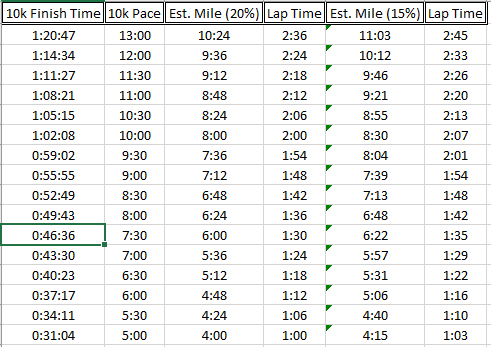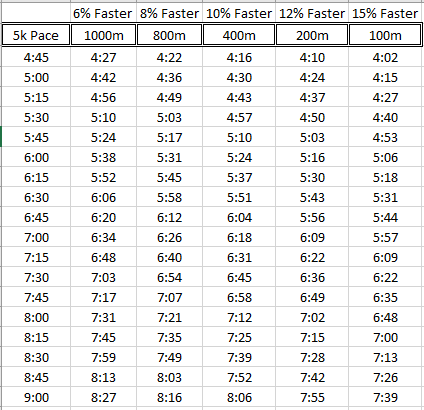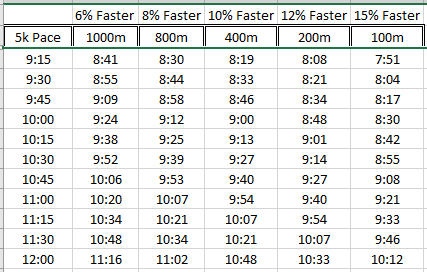How do I find my ideal training paces? My short answer, is that finding your ideal training paces is more of an art than a science. Some heart rate or Vo2 Max data can be used to try to make the process a bit more scientific, but I find that over-complicates things at times. When I’ve tried heart rate based workouts in the past, I found that it took away some of my enjoyment and that I was stressing about paces too much. Admittedly, I probably lacked the proper knowledge to use heart rate training at the time as well. I invite you all to explore heart rate and V02 Max data, but I generally will not refer to these metrics in our workouts.
Another approach is to target different levels of perceived effort. The issue with this approach is that you may not have an accurate view of your effort on certain days. It may feel much harder or easier to achieve the same pace on any given day due to a number of factors. However, in the middle of a track workout, I do recommend referencing your effort level and not just focusing on pace. You need to push yourself to improve, but it is important to listen to your body as well. (For example, if you’re finishing off a long set of intervals, you might find your pace is dropping off a little bit. Generally, the workouts are designed to challenge you maintain your pace, but a realistic evaluation may show that are really just mentally slowing down…pick up you head, look at the horizon, and get it going!).
So, what do I recommend?
Challenge yourself during speedwork and we’ll adjust as needed. As you get more speedwork under your belt, we’ll reassess and get more data to fine tune things. Of course, some of you will already have training paces from prior experience as well. If you’re looking for a starting point of a calibration: 1) Use a recent race result, 2) Use a mile time trial, 3) Check out the Extras Section
1) Use a Recent Race Result
One of the primary benefits of using online calculators is that they are very easy to use. Note that some of the calculators will simply divide your pace evenly into shorter distances, which is inaccurate to your potential for shorter intervals. Also, you’ll need to assess the validity of these calculators as we go. If nothing else, these will provide a good starting point or a reference point.
Jack Daniel’s VDOT Running Calculator

One of the best calculators I’ve found available for free online is Jack Daniels’ VDOT Running Calculator, which you’ll find below. Tennessee Whiskey? Nope. Jack Daniels is a two-time Olympic medalist, exercise physiologist, and coach. I own Daniels’ Running Formula book where he elaborates greatly on training. This calculator is a good starting point! Look at the Training Tab to see your Interval and Repeat Paces. The Equivalent Tab is interesting if you’re trying to gauge how things might transfer to another distance.
Capital Area Runners
http://www.capitalarearunners.com/training/interval.html
Capital Area Runners provides a basic chart to reference, which will give you an idea on interval pacing. They use target race times, so it is a little tricky. Since I haven’t contact them for permission to post, please use the link.
Greg McMillan Pace Calculator
https://www.mcmillanrunning.com/
Another world-renowned running coach provides a great calculator online. One of the strengths of this calculator is that you input both your goal time and your current fitness level. It requires you to put in your e-mail, but it appears you can unsubscribe if you like.
2) Use a Mile Time Trial
Coach M@’s Tips for the Mile Time Trial
- Ensure you are warmed up and completed a bit of dynamic stretching.
- Pick a realistic mile time trial goal and figure out your per lap time.
- Try not to stare at your watch too much by only using it as a quick reference.
- Use your watch or a friend/trustworthy stranger/coach to note your lap time for the first lap.
- If you’re behind your initial estimate or goal; don’t panic and quickly assess you’re ability to turn it up a little on lap #2. If you’re ahead of schedule; don’t automatically dial back your pace. I recommend continuing to target your original pace for lap #2, but it depends on how well you know yourself.
- Congrats, you’re half way there! As you enter lap #3, it’ll likely start to feel a little rough. My recommendation is to focus on driving your arms.
- Lap #4 will take whatever you have left. Finish strong! Keep your head up with your eyes on the horizon. Use a mantra if you like. I recommend looking upward toward your brain and saying “my mind’s up here!”. It may sound silly, but you probably don’t want to think about maintaining your cadence (foot turnover) so it might be worth a shot.
Steve Cram’s Tips for the Mile Time Trial
https://www.telegraph.co.uk/health-fitness/body/steve-crams-top-10-tips-running-mile-faster-ever/
It is a challenge to pace yourself properly for a mile time trial since you’ll be pushing at a pace you likely can’t sustain for much longer. You should be feeling pretty beat by the end. As with all runs, make sure you are warmed up properly before starting. Don’t stress about your time too much, this is only a guideline. Steve Cram suggests that your mile time should be 20% of your 10k Pace. I’ve included a 15% off estimate as well to give you a range. Again, these are just for reference; just push yourself and go for it!

Jeff Galloway’s Magic Mile
http://www.jeffgalloway.com/training/magic-mile/
Jeff Galloway is a world-famous running coach and is perhaps most well-known for his run/walk strategy. He is also known for the Magic Mile, which uses your mile time trial pace to predict your training and race paces. You obviously need to factor in endurance capabilities as running a marathon is demanding in a very different way than a mile time trial. Also, it relies heavily on the accuracy of your mile time. Running your optimal mile time takes practice and can be difficult. However, I’ve found the Magic Mile to be reasonably accurate in my experience. Check it out on the site or I’ve made some charts below. Just add 33 seconds to your mile time for 5k Pace.
3) Extras
Runner’s World Training Pace Calculator
https://www.runnersworld.co.uk/rws-training-pace-calculator
Use your recent race time to get a general idea of your training paces.
Cool Running Pace Calculator
http://www.coolrunning.com/engine/4/4_1/96.shtml
Here is a very basic pace calculator. Enter two to calculate the third (Time, Distance, & Pace).
North American Academy of Sport Fitness Professionals guidelines
The NAASFP notes that one should be able to run shorter intervals slightly faster than 5k Pace. Since a lot of our club runs half and full marathon, I will frequently limit things to 5k Pace. However, I welcome everyone to turn up the pace on shorter intervals as well! I may refer to these paces as 5k Plus Pace or All-Out Pace (for 200m or 100m intervals).




